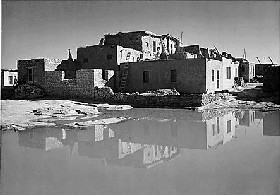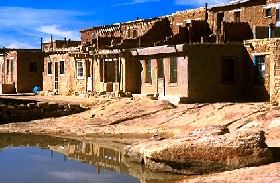Acoma Pueblo - Ancient Sky City
 S
Strategically built atop a 357-foot sandstone mesa for defensive purposes, the Acoma Pueblo is more familiarly known as Sky City. Believed to be the oldest continuously inhabited city in the United States, the pueblo is thought to have been built prior to the 10th century. In ancient times, the only access to the top of the pueblo was by means of a hand-cut staircase carved into the sandstone.
The name "Acoma" means People of the White Rock in the Puebloan Kersan dialect. The pueblo, covering some 70 acres, is actually comprised of several villages including Acomita, McCartys, Anzac and Sky Line.
For centuries the Acoma people have dry-farmed the valley below the Acoma Pueblo using irrigation canals in the villages closer to the Rio San Jose River.
For centuries, the Acoma people were known to trade, not only with neighboring pueblos, but also over long distances with the Aztec and Mayan peoples.
In 1540, Francisco Vasquez de Coronado was the first European to lay eyes on the Acoma Pueblo, describing it as: "One of the strongest ever seen, because the city was built on a high rock. The ascent was so difficult that we repented climbing to the top."
Almost fifty years later, Sky City was almost destroyed in 1598 when Govorner Juan de O�ate and 70 of troops attacked the pueblo in retaliation for the killing of 13 Spanish soldiers by the Acomas when they tried to take grain from their storehouses.

As a gesture of peace, the Spanish began to build the San Est�ban del Rey Mission in 1629 with building materials that were hand carried and hauled up the steep slopes of the mesa. The mission�s 30-foot beams were carried 30 miles from Mount Taylor and Kaweshtima while the dirt for the cemetery was carried up the mesa from the valley below. Under the guidance of Friar Juan Ramirez the pueblo was finally completed in 1640
Today's Acoma people continue the traditions of their ancestors who they trace to the former inhabitants of older ruins to the north and west of their present-day pueblo. Some also practice their ancient religion while others converted to catholocism long ago when the first Spanish settlers arrived in the 1500's. Throughout the years celebrations and feasts are held for relegious and historic occastions. While visitors are allowed to attend, they are encouraged to be respectful and aware of local protocol.

Today, fewer than 50 of the 3,000 Acomans live at the pueblo, the remaining residents choosing to live in the nearby villages. This city is known for its amazing pottery and a permanent exhibit, One Thousand Years of Clay, is housed in the Visitors Center located at the base of the mesa along with native food and crafts shops.
Both the San Est�ban del Rey Mission and the Pueblo itself have been proclaimed National Historic Landmarks. The tribe also operates the Acoma Route 66 Interpretive Center just off I-40 and the Acoma Commercial Center. In addition, the pueblo also offers fishing for a fee at its newly built Acoma Lake.

The pueblo is located 60 miles west of Albuquerque on Interstate 40 and 12 miles south on Indian Route 23. From Grants, Acoma is just 12 miles east on I-40. The pueblo is not open to the public on a daily basis and visitors must obtain visitor and camera permits from the Sky City visitor center at the base of the mesa.


